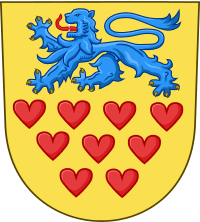King of the Goths
- This is about the medieval title; for the migration-era Goths, see King of the Visigoths, King of the Ostrogoths.
The title of King of the Goths (Swedish: Götes konung, Danish: Goternes konge, Latin: gothorum rex) was for many centuries borne by both the Kings of Sweden and the Kings of Denmark, denoting sovereignty or claimed sovereignty over the ancient people of the Goths, an east Germanic people.
To kings of Denmark, it chiefly meant the island of Gotland, traditionally interpreted as the original home of the Goths, and to kings of Sweden, it meant one of the three constituent parts of that kingdom (see Lands of Sweden), Gothenland, the southern part of Sweden.
Preludes
A papal letter from about 1100 is directed to two Swedish kings—Inge the Elder and Halsten or Håkan Röde (only the initials are given)—as Kings of the Visigoths, which has been interpreted as meaning that they only ruled over Westrogothia, and had lost control over the rest of the country.
In a papal letter dated 5 September 1164, king Charles VII of Sweden (Karl Sverkersson) (c 1130–67; reigned 1161–1167) was addressed as rex Sweorum et Gothorum.
Hunnic title
According to historical accounts, Attila the Hun was styled "Attila, Descendant of the Great Nimrod. Nurtured in Engaddi. By the grace of God, King of the Huns, the Goths, the Danes, and the Medes. The Dread of the World".[1]
Sweden's title
The first Swedish king to regularly use the title was King Magnus III of Sweden, particularly after he had in c 1278 had his final win over his deposed brother Valdemar who had hitherto held lands of Västergötland. First Sveriges och Götes Konung up to later decades of Gustaf I of Sweden, then Sveriges, Götes och Vendes Konung, was used in official documentation. Between 1814 and 1905 Sveriges, Norges, Götes och Vendes Konung was used, adding Norway. Sveriges, Götes och Vendes Konung was used again from 1905 up to the accession of Carl XVI Gustaf of Sweden in 1973, who was the first monarch officially proclaimed Sveriges Konung ("King of Sweden") and nothing else.
Denmark's title
The first Danish king to use the title was King Valdemar IV (reigned 1340 to 1375), who adopted it in 1362[3] after conquering Gotland the previous year. The Danish Kings continued to use the title over the next six hundred years until 1972, when Queen Margrethe II succeeded. She abandoned the use of all her predecessors' titles except her title as 'Denmark's Queen', which is the royal style today.
First documented 1449,[3] the arms of the Danish monarchs contained until 1972 a subcoat representing the title King of the Goths: on gold, a blue heraldic leopard above nine red heraldic hearts. Originally derived from the arms of the dukes of Halland which again was derived from the Danish arms. This symbol is consequently unrelated to Gotland's arms featuring the Agnus Dei, although the latter symbol was also formerly represented in the arms of Denmark.
See also
- kings of the Goths known by name before the 3rd-century split into Visigoths and Ostrogoths:
- King of the Visigoths
- King of the Ostrogoths
- King of the Geats
- King of the Wends
References
- ↑ Creasy, Edward Shepherd (1969). "Chapter VI. The Battle of Chalons, A.D. 451". Fifteen Decisive Battles of the World from Marathon to Waterloo (Harper ed.). Heritage Press/BiblioLife. p. 149. ASIN B000LF91OK.
- ↑ Forsvaret.dk - Om Jydske Dragonregiment
- 1 2 Svane, Erling: Det danske Rigsvåben og Kongevåben, Odense University Press, 1994, p. 172 (in Danish)
Sources
Further reading
- J. Guinchard (1914). Sweden: Historical and statistical handbook. Stockholm: P. A. Norstedt & Söner. p. 188.
